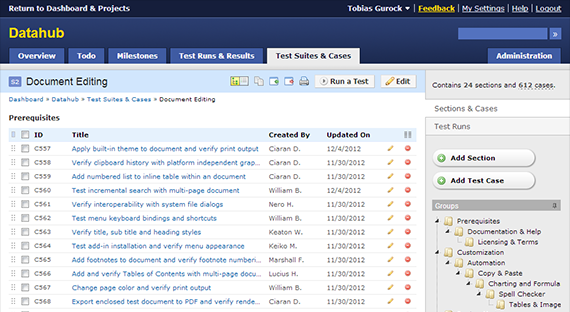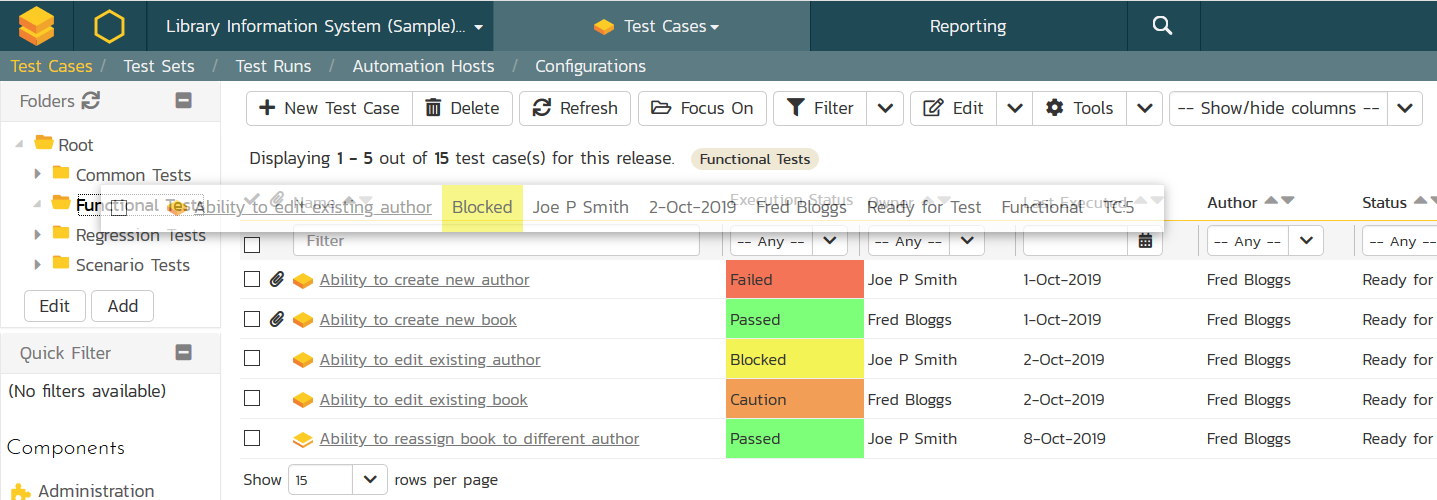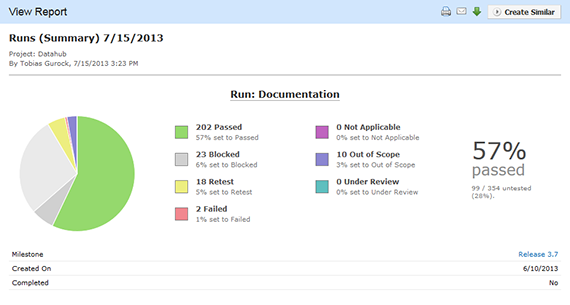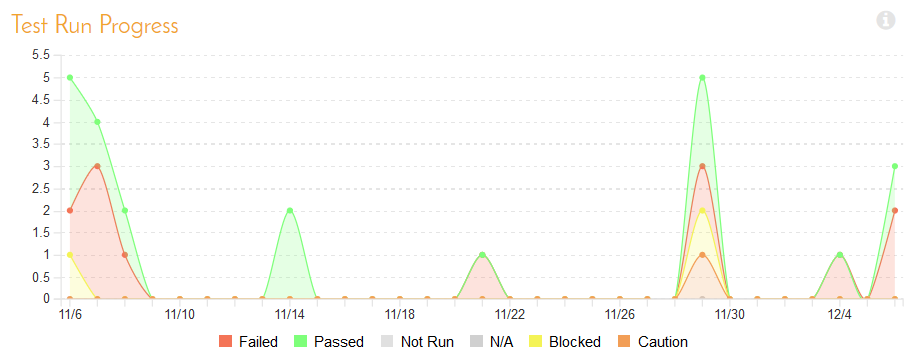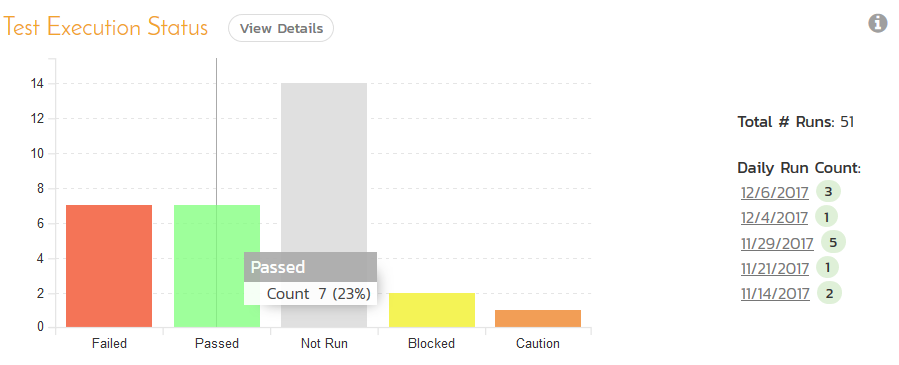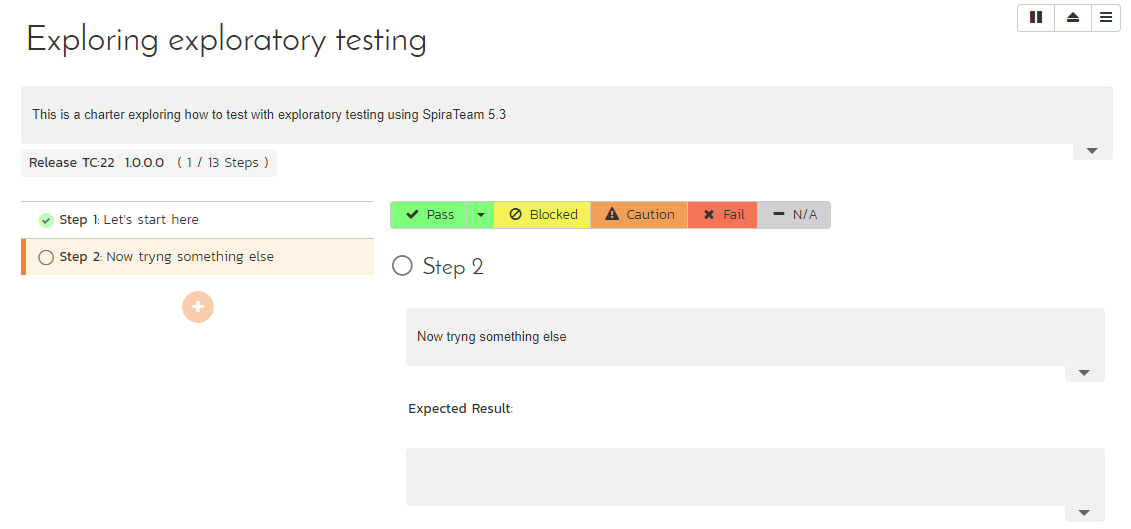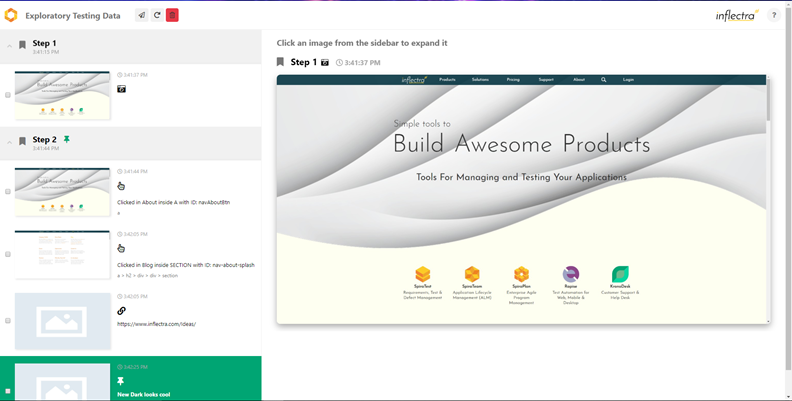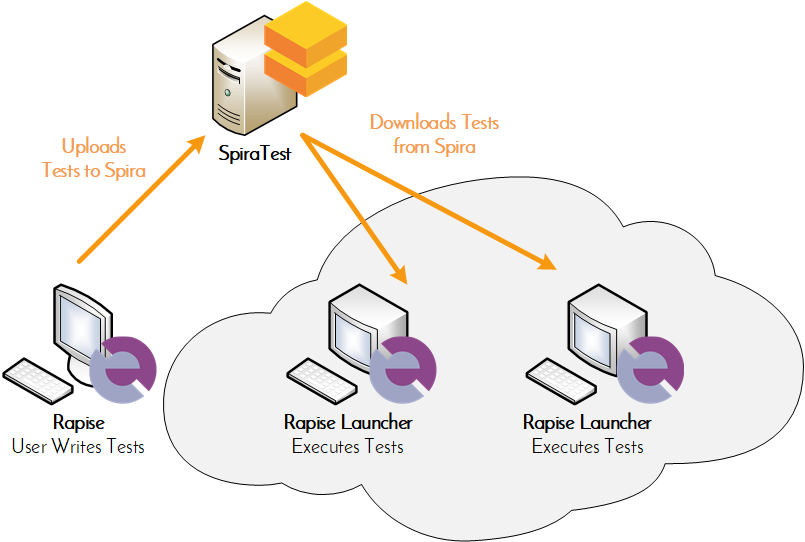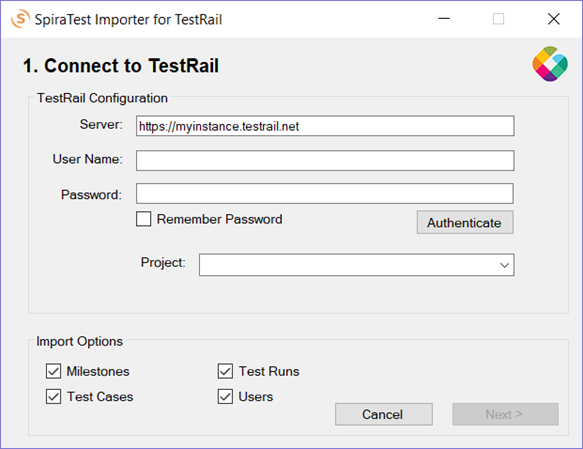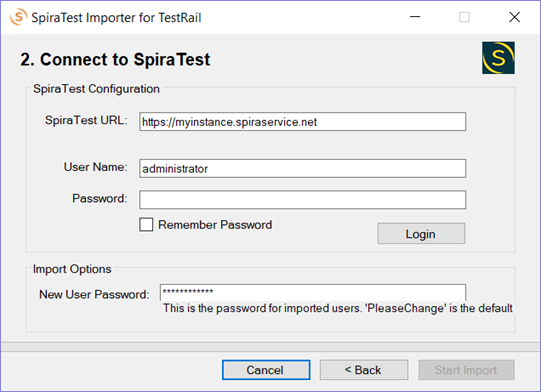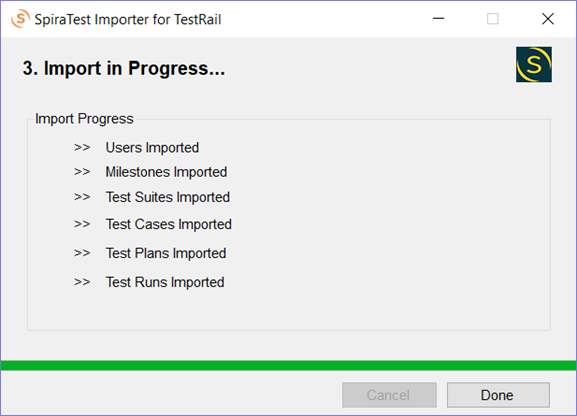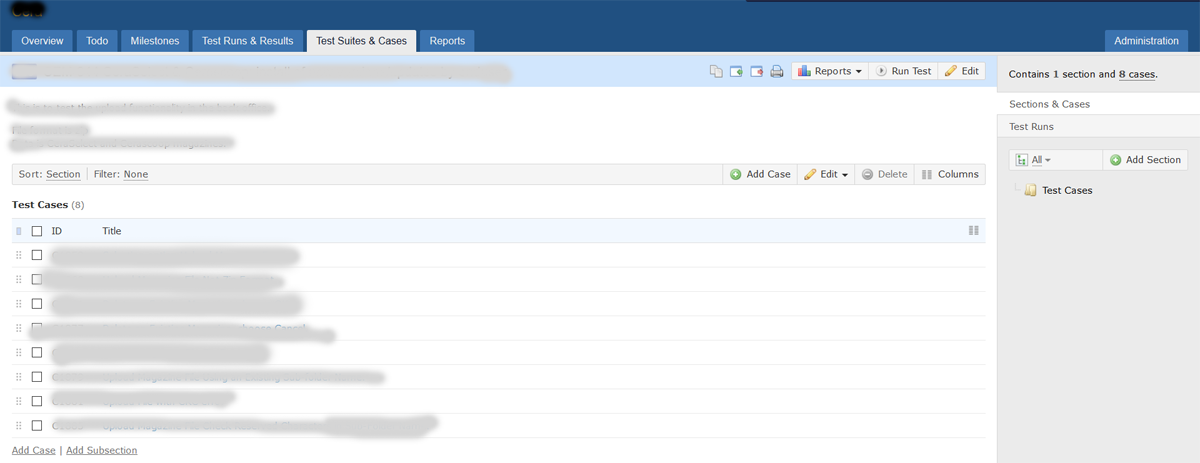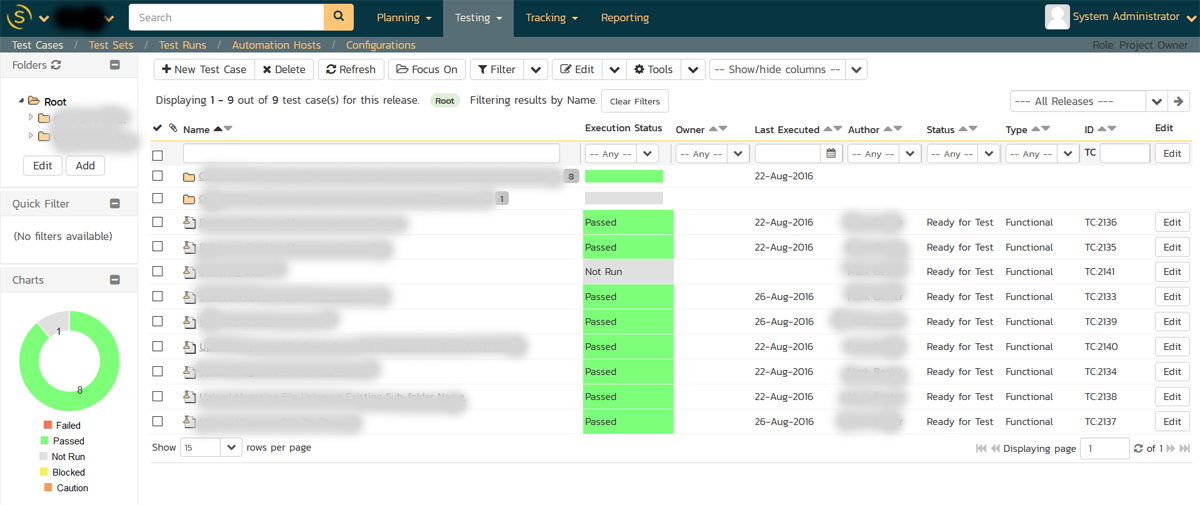1) TestRail Only Handles Test Cases & Test Runs
TestRail is a pretty basic application, it lets you write test cases, organize them into suites and sections, and then execute them, recording results, that's pretty much it:
SpiraTest is much more complete test management system. It lets you write test cases, organize them into folders, assign them quickly and easily to testers using the test sets feature and then the testers can log their defects right inside SpiraTest. Unlike TestRail, you don't have to launch another application (such as JIRA) to log your defects.
Furthermore, SpiraTest includes out of the box support for managing your requirements and defects, you can schedule and orchestrate automated testing using the Automation Hosts feature, and for more advanced data-driven testing you can use Test Configurations to manage your test data, right inside SpiraTest:
Without the support for requirements management, and with lack of a native defect tracking capability, TestRail cannot give you important QA metrics such as requirements test coverage:
2) SpiraTest has Full Support for Test Steps
TestRail has never really had proper native support for test steps. It treats all test cases as one large test step, with the results reported back against the test case as whole, not against specific steps. Over the years, TestRail has added some partial support using custom fields (called custom steps) using a special template:
More recently this custom template was made a standard option for TestRail, but it doesn't provide the full support for test steps that a real test management solution should have.
With SpiraTest, each test case has multiple test steps,each step has its own execution status and actual result when passed. You also have some advanced features that let you have templated test cases with parameters and data-driven testing available out of the box:
3) Easy to Use Drag and Drop User Interface
TestRail has an old-fashioned, traditional web interface, where operations such as editing test cases, moving items, navigating between items requires separate page loads, lots of clicking and pointing:
On the other hand, SpiraTest has a brand new AJAX user interface where we minimize page loads, and operations such as editing can be done inline, and moving test cases between folders is as sample as dragging and dropping the test cases onto the folder name:
Of course, SpiraTest is fully mobile-responsive, using modern web frameworks such as Bootstrap and ReactJS to deliver, fast, fluid experiences.
4) Powerful, Flexible Reporting
TestRail has very limited reporting options, with a simple set of pie and line charts available to the user:
SpiraTest on the other hand, has a powerful set of reporting dashboards where you can select from a large range of graph types (spline, donut, line, bar, etc.) and create a custom reporting dashboard to suit your needs with just a few clicks:
Using the latest JavaScript c3/d3 reporting platform, the SpiraTest graphs and reports offer real-time data highlighting and tooltips that let you drill down into the data.
Finally, there is a built-in report document generator that lets you publish sophisticated reports in PDF, MS-Word, Excel, HTML and XML formats. The custom report writer built into SpiraTest lets you create reports from scratch using the built-in query language so that you can generate all of your company's metrics from within SpiraTest.
5) Built-in Support for Exploratory Testing
Finally, unlike TestRail, SpiraTest includes a new, built-in Exploratory testing mode that lets you perform exploratory and session-based testing from within SpiraTest, and still get the benefits of requirements traceability and real-time reporting:
In addition to the native support within SpiraTest for exploratory testing, there is a free add-on called SpiraCapture that lets tester run exploratory sessions inside their Chrome web browser and automatically capture their actions and screenshots.
Once they have identified the important steps and actions, they can file this within SpiraTest as a new issue report or test result.
6) Automation Testing Built-In
TestRail is primarily designed to be a manual testing tool, with its focus on test cases, test sections and test suites. When you start to look at integrating automated testing you quickly find its limitations.
SpiraTest has test automation built in, with support for either writing and executing tests in our own Rapise test automation tool and executing them from SpiraTest, or integrating other third-party tools and open-source frameworks with RemoteLaunch.
7) Better Synchronization with Jira and Azure DevOps
Finally, the integration between SpiraTest and other development lifecycle tools such as Atlassian Jira, Microsoft Azure DevOps, GitHub, and GitLab is much more powerful and seamless than TestRail. In addition to synchronizing new issues logged in SpiraTest with these other systems, our synchronization service handles updates, attachments and changes in both systems.
This means that your developers and testers can work in the most appropriate tool for the task and our system takes care of keeping the data in sync.
So, if you are interested in switching from TestRail, we have made it really easy for you, with our free TestRail migration tool…
How to Migrate from TestRail
The new migration tool makes importing your projects from TestRail a breeze. All you do is install the migration tool and connect to your TestRail instance, selecting the name of the project you wish to migrate:
You then connect to your instance of SpiraTest and select which artifacts in the project you want to migrate:
Once you click the Start Import button, the migration wizard will quickly and seamlessly migrate over your project from TestRail to SpiraTest:
What Does The End Result Look Like?
Once the migration is done, your old, legacy project in TestRail:
Will now be a new shiny project in SpiraTest. It will have all your project data migrated over, and you can now have the benefits of working within SpiraTest instead:
Since the terminology and project organization between TestRail and SpiraTest is a bit different, here's a quick guide to how the artifacts migrate over:
| TestRail | SpiraTest |
| Project | Project |
| Milestone | Release |
| Test Suite | Test Case Folder |
| Test Section | Test Case Sub-Folder |
| Test Case | Test Case |
| Custom Step | Test Step |
| Test Plan | Test Set |
| Test Run & Test | Test Run |
| Test Result | Test Run Step |
If you have any questions about migrating from TestRail to SpiraTest, please contact us and we're here to answer your questions.
Try SpiraTeam free for 30 days, no credit cards, no contracts
Start My Free TrialAnd if you have any questions, please email or call us at +1 (202) 558-6885






